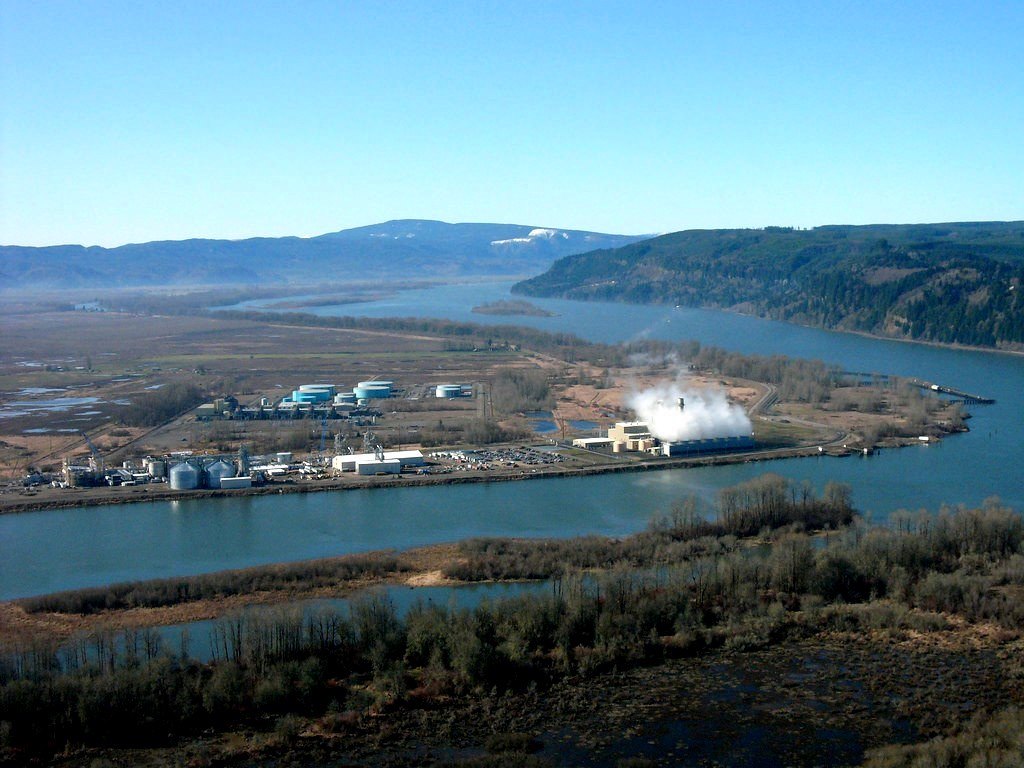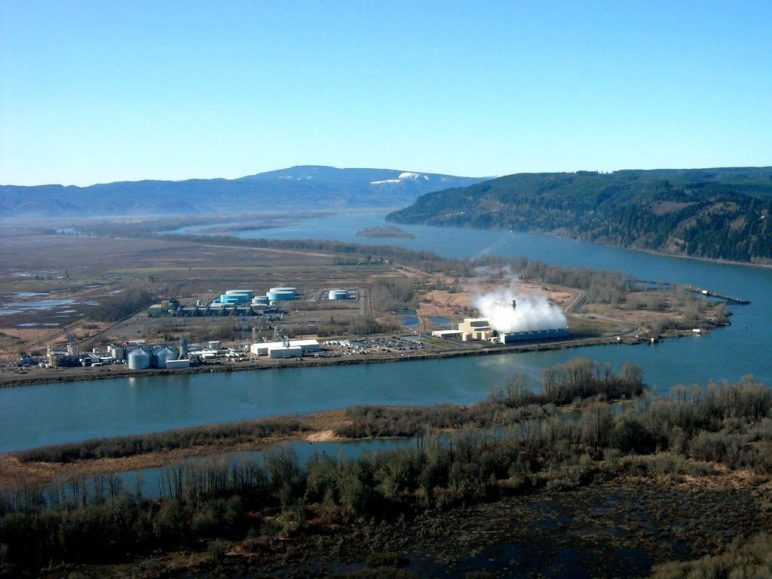The proposed giant methanol project in Kalama, Washington, would be a resource hog of the highest order, with a climate impact to match.
Running the plant would lap up 100 megawatts of electricity, enough to power about 100,000 homes, from the region’s electricity grid. Plus, the facility’s operations would demand 320 million cubic feet of fracked gas daily—more than every power plant in Washington combined—a portion of it to run a new gas-fired power plant planned for the site.
An initial environmental assessment found that the Kalama plant would have the same climate impact as adding 260,000 cars to the roads, increasing the state’s carbon footprint by 1.28 percent at a stroke. A state agency subsequently sent that assessment back to the drawing board for failing to consider the added climate impacts of extracting and transporting huge quantities of gas.
And yet the reality is likely even worse. The assessment accepts at face value the project backer’s claim that the plant’s methanol wouldn’t be burned, but instead would be converted into plastics and stored in manufactured goods.
A careful review of the evidence reveals this claim as wishful thinking at best, and intentional deception at worst. The fact is that China has begun a major push to use methanol as a fuel for the country’s vehicle. In other words, the Kalama methanol project is not an industrial manufacturing site, but rather an enormous refinery for China’s cars.
Even the project backers acknowledge that the Kalama plant’s methanol will wind up in Chinese fuel tanks. An April 2017 China Daily article quotes We Lebin, the chairman of the Kalama project’s parent company, saying that the plant’s output could “replace diesel, coal and gas with methanol to power vehicles.” Lebin doubled down on the claims in a December 2017 Reuters article, saying that, “[the company] also wants to drive use of methanol as a transportation fuel for cars and ships.”
Similarly, a summer 2017 industry conference sponsored by the project backers focused on the prospects of using methanol as a liquid fuel. The conference reading materials do not even mention using methanol to make plastic.
Analysis from the industry itself underscores the point. Although methanol is a remarkably utilitarian petrochemical—it is used in everything from wastewater treatment to paints and resins—about half of all methanol is used as a fuel globally. And nowhere is demand growing faster than China, where it is seen a key ingredient in powering the country’s burgeoning fleet of cars and trucks. According to leading industry sources, “Chinese direct blending use of methanol into the country’s gasoline pool has seen an average annual growth rate of 25 percent from 2000 to 2015.” And this view is corroborated by the US Energy Information Administration, which has documented the meteoric rise in China’s use of methanol as a liquid fuel, primarily as an additive to gasoline.
 To make matters worse, industry forecasters believe that China’s plastics industry may soon be glutted with methanol. If the supply of methanol outstrips demand, then the logical use would be to blend it into gasoline or other fuels, a fairly straightforward process. Other industry sources point out that China’s overdrive for methanol is underpinned by using it as a fuel for cooking, heating, and transport.
To make matters worse, industry forecasters believe that China’s plastics industry may soon be glutted with methanol. If the supply of methanol outstrips demand, then the logical use would be to blend it into gasoline or other fuels, a fairly straightforward process. Other industry sources point out that China’s overdrive for methanol is underpinned by using it as a fuel for cooking, heating, and transport.
China is (and will likely remain) a major center of plastics manufacturing using methanol derivatives. But at the same time China’s policies clearly aim to burn ever-increasing quantities of methanol in the country’s transportation system. That means every ton of Northwest-produced methanol would, in effect, support both activities—either it directly would be burned as a vehicle fuel or it would free up other supplies of methanol for use in gas tanks.
The climate impacts of using methanol for fuel would likely not be good. Researchers at Stockholm Environment Institute analyzed the economics of blending gas-based methanol with gasoline and concluded that the switch would drive large increases in greenhouse gas emissions. In any event, the real-world implications of feeding China’s appetite for methanol as a vehicle fuel would likely be to displace and delay the uptake of cleaner electric vehicles. There is, therefore, little reason to believe that the true carbon profile of Northwest-produced methanol can be measured by imagining it sequestered in plastics products.
If the methanol is burned and emitted into the atmosphere then the greenhouse gas implications would be drastically worse than anybody seems to realize. A fair accounting of the project’s impacts would do the math on methanol-as-fuel, but that analysis is unlikely to happen unless Washington’s Department of Ecology steps into the breach to force a fuller review of the project. Only then could state and local permitting agencies make an informed choice about whether to allow the state to become a fuel refiner and supplier to China.
Update 2/4/19: The chairman of the company behind the project, Wu Lebin, is continuing to advertise to investors that methanol made in the Northwest would be used as a fuel in China. See, for example, this description of his speaking role at a November 2018 conference for investors.











Kyle M.
I’ve heard the backers of the project passionately insist that the methanol for vehicles will be displacing diesel and dirtier methanol produced in China, and it would therefore be a net gain on the emissions front.
I didn’t see that argument addressed head on in this piece, aside from just saying the methanol supply would delay the uptake of electric vehicles. Is there any research on that front?
The assumption here seems kind of zero sum (China will build as many methanol plants as they can no matter what we do, so if we increase the supply we’ll just drive down prices and increase demand for uses in fuel and plastics). But the backers of this project seem to think that if we create a relatively cleaner supply there won’t be as much of a need for China to build as many new methanol plants…
I’m not an advocate for the methanol plant, just to be clear.
Eric de Place
Great question. I explored these issues a bit in a June 2016 article, here: http://www.sightline.org/2016/06/23/examining-methanols-green-claims-in-the-northwest/
The short version is that the company’s claims seem to mostly be just assertion. There’s very little evidence to suggest that NW production would displace any meaningful quantity of dirtier-produced methanol. Moreover, there’s decent evidence that gas-to-methanol is actually not a very clean route to plastics production relative to other available methods. So it looks like the project is mostly about finding cheap feedstocks for Chinese manufacturing, not clean ones.
Phil B.
Adding to your comment, Eric, NWIW engages in alot of hedging in their missives to regulators & greenwashing the public. For example, NWIW claims they’ll be using clean hydro for their energy source, when no excess hydro or renewable energy is available on that scale, when they’ll actually end up building a dedicated fracked gas power plant. They also claim ULE (ultra low emissions) technology MAY be used, when it’s not even available on an industrial scale. NWIW also claims an intention to recycle a vast majority of their water use, when the reality is 80%-90% (?) of these massive amounts of water are let off as steam & thus unrecoverable.
This project doesn’t hold up to even the slightest amount of scrutiny.
Phil B.
This is important research to counter NWIW claims of plastics production. The SEIS measuring cumulative ‘cradle to grave’ emissions should absolutely take into account this fracked gas will destroy upstream communities, consume massive amounts of fresh water and electricity locally, while creating risk to the Northwest, before it’s shipped halfway around the planet and poured into gas tanks. There is no reason to believe otherwise, and sufficient evidence to suggest it will.
It’s a curious thing how these massive fossil fuel projects and their well-paid hucksters steer through our regulatory processes.
Marrene Jenkins
Fuel for other modes of transportation-planes,ships,and military vehicles as they develop islands in the South China Sea. This is not original to me but was talked about over a year ago. We better be careful when it comes to the Chinese planning.
Lael
One other point: “the China-owned plant will utilize 5,000,000 gallons of water daily from the Columbia and Kalama River aquifers” (from the WA State Environment and Climate Caucus Kalama Resolution).
Terry H
I am no advocate for the methanol plant either, and the drain on our natural resources is alarming and will be ongoing. Regardless of how the methanol is used I don’t want our community being used as a way for China to accomplish its goals cheaply. We have all heard and read stories about communities being used for their natural resources and then being left devastated once those resources are gone (e.g. oil in many US cities – Ponder, TX is one example, in 2011, and not much different in size than Kalama). Let’s not even take that chance because we don’t need their money that badly – we would give up so much for so little and be left regretting it forever!
Paul Thiers
Great Piece, Eric. We Lebin continues to state that this project will produce fuels when he is presenting it to potential investors. He is making a presentation to a caplital investment conference in Beijing later this year and the bio and description of NWIW in the conference program makes this clear. You can see it here.
http://www.internationalcapitalconference.com/speakers/wu-lebin